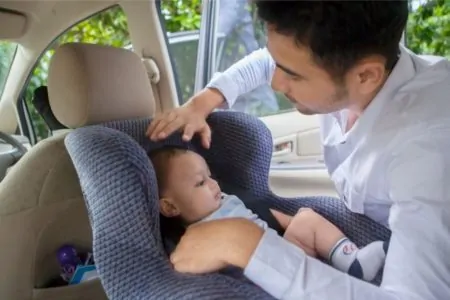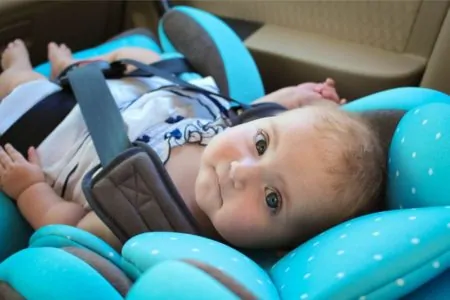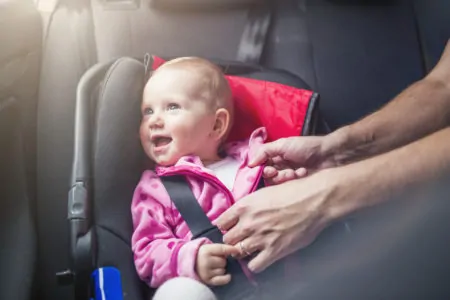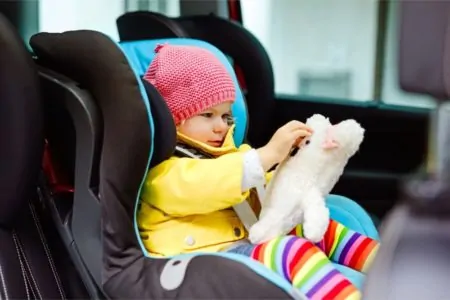Car seats are one of the reasons that injuries and death in children during car accidents have decreased. But car seats aren’t always easy to figure out — they come with many questions, recommendations, and potential struggles. And there’s an ongoing battle about how long a child should be rear facing in their car seat.
We’ll break down the arguments about rear vs. front-facing and discuss what the experts have to say about when to transition your car seat.
We all want our kids to be safe when in the car. Let’s find out how.
Key Takeaways
- Keep children rear-facing until they reach the weight and length limits of their car seat, typically at least until 2 years old.
- Rear-facing car seats offer better protection for a child’s head, neck, and spine during accidents.
- Children are usually comfortable in rear-facing positions, despite concerns about legroom.
- If your child exceeds the infant car seat limits before 2 years old, consider a convertible car seat with higher rear-facing weight and height limits.
When Is the Right Time to Transition?
Parents know that having a baby car seat is a requirement. However, the laws surrounding them and their placement can be daunting and sometimes unclear. One of the most confusing things that parents never seem to know is when to switch the car seat from rear-facing to front-facing.
You have possibly heard that children can ride facing forward after one year or after weighing 20 pounds. This had been the standard for a long time, but recommendations have changed. Currently, the American Academy of Pediatrics (AAP) recommends that children remain rear-facing for as long as possible — until they reach the rear-facing weight and length limits of their car seat, which for most is at least the age of 2 (1).
This newest recommendation doesn’t place a specific age for a child, and it can go well beyond 2 years, possibly up until 4, depending upon your child’s size.
Why Is Rear-Facing Better?
Most manufacturers design car seats that allow children to stay rear-facing until they weigh as much as 40 pounds. Some convertible options reach 50 pounds.
But why design rear-facing seats at all?
In a rear-facing car seat, the hard shell supports your child’s head, neck, and spine. In case of an accident, these vulnerable body parts will be well-protected. On the other hand, when facing forward, your child is only restrained by the harness straps.
Their head, which is disproportionately large and heavy, could be jerked forward. It’s hard to believe, but the head makes up approximately 25% of a child’s body weight. We all know babies are vulnerable, but toddlers and young children are still at great risk even though they look larger.
A child’s vertebrae are not fused until between the ages of 3 and 6. This means the spinal cord is not fully protected when subjected to crash forces. These combined factors could result in a spinal or head injury and possibly death (2).
Even though, as a parent, you’re looking forward to transitioning your child to the next stage, delay this as much as possible. Always check your car seat manual for the manufacturer’s recommended weight and height limit. Once they reach that stage, you can transition them and feel confident in your decision.
Won’t Their Legs Be Uncomfortable?
You may imagine your child’s legs are squished in a rear-facing position. However, children are flexible, and this is the safest position for their legs. If your car crashes, forward-facing kids are at a much greater risk all around.
If they complain about the legroom, take a break and let them stretch. They may also enjoy crossing their legs or hanging them over the sides.
What If They Reach the Car Seat Limit Before 2 Years?
Once your child exceeds the weight and height limit of the infant car seat, it’s time to go out and buy a convertible car seat. These come with higher limits that can go up to 50 pounds rear-facing.
When it comes to height, most car seats recommend at least one inch of room between the top of the child’s head and the top of the seat. This space ensures your child’s head is safe in a crash.
If you have already switched your child to be forward-facing before the recommended age, switch them back. This is exactly what I did when I learned about the recommendations while my toddler was already 2 years old. It gave me peace of mind to know my child was five times safer (3).
Aren’t Rear Car Accidents Just as Bad?
Statistically, rear impacts account for around 25% of all accidents. When they do happen, they usually have less severe injuries compared to frontal or side crashes (4).
Rear car accidents don’t usually carry as much force, given that both cars are usually moving in the same direction. This means the impact won’t be as strong as other types of accidents. Besides, rear-facing car seats are designed to absorb the impact.
What If Your Child Doesn’t Like Rear-Facing?
This is a significant concern to most parents, and for good reason. When a child is crying and wailing, it becomes a distraction for them while driving. The chances of an accident are higher when parents are distracted, thereby risking the whole family’s safety.
Sometimes these tantrums have less to do with the car seat and more to do with the fact that your child is a toddler, and throwing fits is par for the course. However, rear-facing does not necessarily need to be boring.
You can use a car mirror so you and your infant can see each other, but be sure you can firmly secure the mirror so it does not become a projectile in a crash. Things like Velcro won’t hold up when you need it most. Older kids can keep themselves busy with toys or look out the rear window.
After some time, your child will get used to the idea that you’re up front, even if they can’t see you. The safety of your child should always come first. Rear-facing car seats are usually comfortable, so you have nothing to worry about.
Do Rear-Facing Seats Cause Motion Sickness?
This is a misconception. Most people get motion sickness when they look out the side windows. Everything seems to move too fast, which sends mixed signals to the brain.
This can cause uneasiness and motion sickness. If your child struggles with motion sickness, you can hang a sunshade over the window or something else to block out a clear view. You can also try changing the recline level in their car seat (if it’s age-appropriate and your seat allows it) to see if a different view affects their motion sickness.
If you have a vehicle with three rows, keep children who are prone to motion sickness in the second row. This usually gives a smoother ride with fewer bumps.
Editor's Note:
Kristen Gardiner, CPSTChild Car Seat Quick Tips
Here are some things you might need to keep in mind about transitioning your child from rear-facing to forward-facing:
- When it’s time for your child to face forward, use a forward-facing seat that features a harness. Remember to use that forward-facing seat for as long as possible or until they reach the limits for it.
- Once your child reaches that limit, you should start using a booster seat until they are old enough to use the car seat belt. Most children will need a booster seat until they are approximately 4 feet 9 inches, which is typically around 10-12 years of age. Once they stop using a booster seat, ensure they use both the lap and shoulder seat belts for protection (5).











